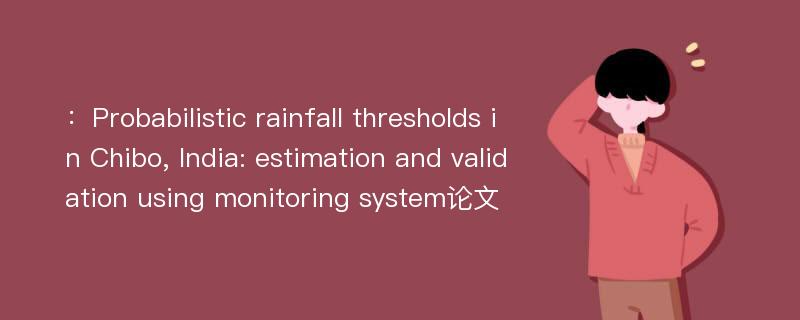
本文主要研究内容
作者(2019)在《Probabilistic rainfall thresholds in Chibo, India: estimation and validation using monitoring system》一文中研究指出:The Himalayan region has been severely affected by landslides especially during the monsoons. In particular, Kalimpong region in Darjeeling Himalayas has recorded several landslides and has caused significant loss of life, property and agricultural land. The study region, Chibo has experienced several landslides in the past which were mainly debris and earth slide. Globally, several types of rainfall thresholds have been used to determine rainfall-induced landslide incidents. In this paper, probabilistic thresholds have been defined as it would provide a better understanding compared to deterministic thresholds which provide binary results, i.e., either landslide or no landslide for a particular rainfall event. Not much research has been carried out towards validation of rainfall thresholds using an effective and robust monitoring system. The thresholds are then validated using a reliable system utilizing Microelectromechanical Systems(MEMS) tilt sensor and volumetric water content sensor installed in the region. The system measures the tilt of the instrument which is installed at shallow depths and is ideal for an early warning system for shallow landslides. The change in observed tilt angles due to rainfall would give an understanding of the applicability of the probabilistic model. The probabilities determined using Bayes’ theorem have been calculated using the rainfall parameters and landslide data in 2010-2016. The rainfall values were collected from an automatic rain gauge setup near the Chibo region. The probabilities were validated using the MEMS based monitoring system setup in Chibo for the monsoon season of 2017. This is the first attempt to determine probabilities and validate it with a robust and effective monitoring system in Darjeeling Himalayas. This study would help in developing an early warning system for regions where the installation of monitoring systems may not be feasible.
Abstract
The Himalayan region has been severely affected by landslides especially during the monsoons. In particular, Kalimpong region in Darjeeling Himalayas has recorded several landslides and has caused significant loss of life, property and agricultural land. The study region, Chibo has experienced several landslides in the past which were mainly debris and earth slide. Globally, several types of rainfall thresholds have been used to determine rainfall-induced landslide incidents. In this paper, probabilistic thresholds have been defined as it would provide a better understanding compared to deterministic thresholds which provide binary results, i.e., either landslide or no landslide for a particular rainfall event. Not much research has been carried out towards validation of rainfall thresholds using an effective and robust monitoring system. The thresholds are then validated using a reliable system utilizing Microelectromechanical Systems(MEMS) tilt sensor and volumetric water content sensor installed in the region. The system measures the tilt of the instrument which is installed at shallow depths and is ideal for an early warning system for shallow landslides. The change in observed tilt angles due to rainfall would give an understanding of the applicability of the probabilistic model. The probabilities determined using Bayes’ theorem have been calculated using the rainfall parameters and landslide data in 2010-2016. The rainfall values were collected from an automatic rain gauge setup near the Chibo region. The probabilities were validated using the MEMS based monitoring system setup in Chibo for the monsoon season of 2017. This is the first attempt to determine probabilities and validate it with a robust and effective monitoring system in Darjeeling Himalayas. This study would help in developing an early warning system for regions where the installation of monitoring systems may not be feasible.
论文参考文献
论文详细介绍
论文作者分别是来自Journal of Mountain Science的,发表于刊物Journal of Mountain Science2019年04期论文,是一篇关于,Journal of Mountain Science2019年04期论文的文章。本文可供学术参考使用,各位学者可以免费参考阅读下载,文章观点不代表本站观点,资料来自Journal of Mountain Science2019年04期论文网站,若本站收录的文献无意侵犯了您的著作版权,请联系我们删除。
